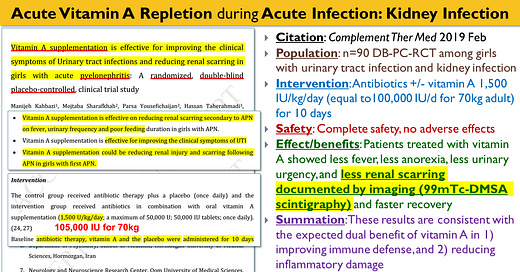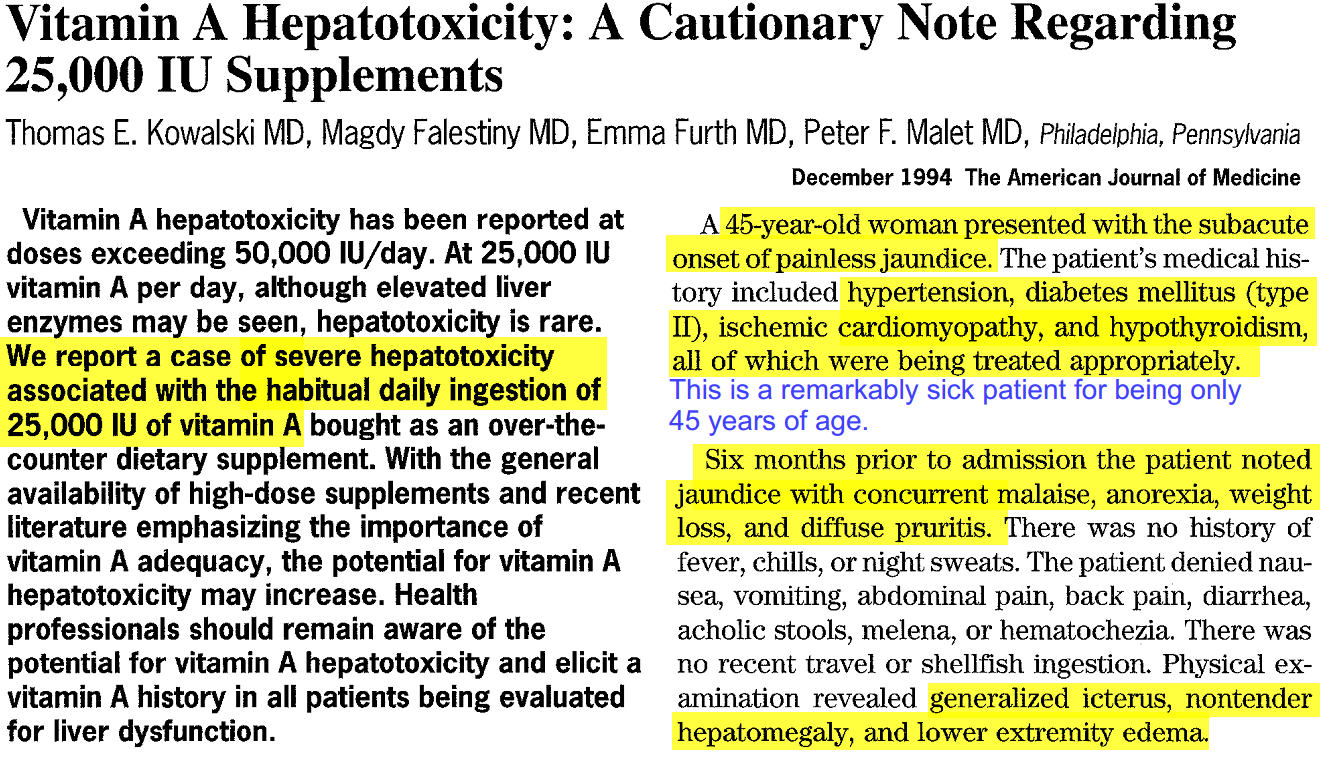Quick Consult on Acute Vitamin A Repletion during Acute Infections and Inflammatory Trauma: Dosing Protocol and Clinical Monitoring
Let's discuss the reasoning, intervention, and monitoring of acute vitamin A repletion during acute infection and trauma
This is the 4th installment in this series on Expert Quick Consults:
1. Quick Consult on Iron Deficiency
2. Quick Consult on Iron Overload
3. Quick Consult on Acute Vitamin D Optimization, especially in acute viral infections
Vitamin A—Overview and Legitimate Toxicity Risk
Vitamin A (retinol, retinoic acid) was one of the first nutrients to be isolated and was quickly recognized for its importance in anti-infection defense, such that it was awarded the nickname the “Antiinfection nutrient.” Indeed, vitamin A is essential for:
Immune defense against infection,
Maintenance of epithelial barriers (similar to vitamin D), and for
Balancing of inflammation with tolerance, aka immunomodulation (exactly like vitamin D).
NARROW THERAPEUTIC INDEX: Vitamin A (along with iron) is one of the only essential nutrients that presents a legitimate risk of toxicity with therapeutic doses; this is what we describe in Medical Pharmacology as a narrow/small/low therapeutic index: the useful dose is very close to the harmful dose. Manifestations of toxicity can appear quickly with acute high-dosing (ie, intensity) or chronically with lower doses (ie, duration). I recall one publication specifically stated that toxicity can be seen with acute/subacute dosing of 600,000 IU, and that is a number that I keep in mind for my dosing plan for adults, as you will see below.
REAL TOXICITY (see video below): A handful of articles/cases have been published showing supposed toxicity of vitamin A at doses of 25,000 IU/d when used long-term; I think that most of these articles are alarmist; however they do set a medicolegal precedent that we need to keep in mind. Also, women who are pregnant or might become pregnant are advised to keep their vitamin A intake below 10,000 IU/d (I typically recommend <8,000 IU/d just to be safer) from all sources to avoid hypothetical/controversial risk of birth defects attributed to vitamin A—based originally on very controversial animal studies.
UNITS OF MEASURE: Vitamin A was previously measured in International Units (IUs) just like vitamin D and vitamin E. Nowadays, vitamin A is measured in retinol activity equivalents (RAE) which are described in units of micrograms (mcg RAE). To convert IU to mcg RAE, use 1 IU retinol = 0.3 mcg RAE. If someone insists on using IU to describe vitamin A and vitamin D, it's probably because they have been studying nutrition for many decades and they don't see any point in changing units just to appease some unnamed group of clinically inexperienced bean-counters :-) The vast majority of research has used and continues to use IU—international units—to describe the dosing of vitamin D, vitamin A, and vitamin E.
Vitamin A—Beyond Measles
All major public health and pediatric medical organizations pay respect to the importance of vitamin A repletion during acute measles virus infection.
According to the WHO website (see video below for text), at least 2 million people (mostly children) die each year from complications of vitamin A deficiency; the most common complication of vitamin A deficiency is any/all infectious disease including viral respiratory infection. When people die from these deficiency-facilitated infections, the medical profession advocates for injexxions (despite high rate of failure and lack of real-world protection) and CO2-trapping facemuzzles instead of addressing the underlying nutritional deficiency; this ensures durable hegemony (ie, dominance) and profitability (ie, they get your cash and your taxes) for the drug/medical cartels while actual health is not protected nor improved.
The international medical profession appreciates the acute depletion of vitamin A that occurs during measles infections, as if that were the only occurrence; as you can see from this 2019 article published by Medscape, WHO recommends 200,000 IU per day on two separate days for a total of 400,000 IU for children older than one year.
Personally and professionally, I don’t see any reason that these recommendations should not also apply 1) to adults with acute (viral) infections, and 2) to all infections and inflammatory insults. In the treatment of adults with acute viral infections, I typically recommend 100,000 IU on day one, the same on day two, followed by 50,000 IU for the next four days for a total of 600,000 IU for adults, distributed over six days. We monitor for toxicity by assessing for the basics (eg, headache) as described in the video below; if toxicity/headache develop, then we can reduce the dose, skip a day, or discontinue; this is rarely a problem, and I’ve never seen it become a serious problem as long as we provide the correct dose for the correct duration with the correct information and the correct supervision.
“Changes in liver and kidney function lead to increased urinary loss of vitamin A during inflammation and infection.
When people are acutely sick or inflamed, they actually lose vitamin A through their urine, thus making them increasingly vulnerable to both inflammation and infection, as I discuss in the videos below.” Dr Alex Vasquez
The WHO and other organizations know (via their own documents and/or widely available research/reviews) that most people have multiple nutritional deficiencies—not simply that of vitamin A—and that these nutritional deficiencies all cause immunosuppression and exacerbation of infection. Thus, the only reasonable and ethical and cost-saving course of action is to address any/all nutritional deficiencies, including protein, zinc, vitamin D, and selenium as I have addressed in the Antiviral Nutrition Course and in my Foundational Diet Protocol.
Vitamin A—Loss and Catabolism during Acute Infections and Inflammation
To understand the importance of providing this immune-supporting nutrient during times of acute infection, you need to know that:
Many people have marginal or deficient vitamin A status, so their tanks are near empty at the start of the challenge. Many people, especially women (25-45% in some studies) have impaired ability to convert beta-carotene to vitamin A.
Increased metabolic demand of severe/acute infection utilizes or destroys vitamin A, exactly when it is needed.
Changes in liver and kidney function lead to increased urinary loss of vitamin A during inflammation and infection. Yes, you read that correctly—when people are acutely sick or inflamed, they actually lose vitamin A through their urine, thus making them increasingly vulnerable to both inflammation and infection, as I discuss in the videos below.
CLINICAL PEARL: The changes in hepatic-renal handling of vitamin A that lead to loss of vitamin A are mediated by cytokines especially IL-6, which also raises CRP blood levels, which is an easily-to-obtain laboratory marker. Thus, if you see an elevated CRP during acute infection-inflammation, then you are probably looking at a situation of increased vitamin A loss that needs compensatory supplementation.
Clinical and Conceptual Goal of Treatment: Dosage? Serum levels? Blood Tests? Clinical Outcomes?
For “Acute Vitamin A Repletion during Acute Infections and Inflammatory Trauma”, treatment is directed by the dosing as I have described above because lab tests are either unnecessary or (more commonly) unreliable, especially in the acute setting. Remember, in this conversation we are talking about acute short-term problems that need acute-short-term solutions; therefore—by definition—long-term toxicity is not a concern and any short-term '“toxicity” (eg, headache) should resolve within a day or two. Remember to limit treatment in writing with clear instructions that the patient/caregivers/staff understands so that treatment is for only a few days with a maximum of 7-10 days before either termination or re-evaluation.
HERE is a CLINICAL PEARL from DrV: The changes in hepatic-renal handling of vitamin A that lead to loss of vitamin A are mediated by cytokines especially IL-6, which also raises CRP blood levels, which is an easily-to-obtain laboratory marker. Thus, if you see an elevated CRP during acute infection-inflammation, then you are probably looking at a situation of increased vitamin A loss that needs compensatory supplementation.
Serum response directs treatment with vitamin D3: For Acute Vitamin D3 Optimization during acute viral infections, the intervention is based on optimization of serum 25ohD levels, ie the blood levels of vitamin D are the reference standard that directs treatment. The reason for this is because we have enough experience, research, and knowledge of the pharmacodynamics and pharmacokinetics to know that this is the best approach, aided by a reasonably reliable laboratory test for vitamin D status, which we do not have for vitamin A status—therefore, laboratory testing does not direct our intervention with vitamin A.
All of the 3 videos below are part of DrV’s FREE Antiviral Nutrition Course
These videos (above and below) are available for download and personal use from
inflammationmastery-com-ichnfm-org.dpdcart.com
The video below is a casual introduction to the concept of nutritional neglect and specifically the role of vitamin A depletion in acute infection.
Dr Alex Kennerly Vasquez (introduction; brief Bio-CV) writes and teaches for an international audience on various topics ranging from leadership to nutrition to functional inflammology. Major books include Inflammation Mastery, 4th Edition (full-color printing, 1182 pages, equivalent to 25 typical books [averaging 60,000 words each]), which was also published in two separate volumes as Textbook of Clinical Nutrition and Functional Medicine (Volume 1: Chapters 1-4; Volume 2: Chapter 5—Clinical Protocols for Diabetes, Hypertension, Migraine, Fibromyalgia, Rheumatoid Arthritis, Psoriasis, Vasculitis, Dermatomyositis and most other major inflammatory/autoimmune disorders); several sections have been excerpted including Antiviral Strategies and Immune Nutrition (ISBN 1502894890) (aka, Antiviral Nutrition [available as PDF download] and Brain Inflammation in Chronic Pain, Migraine, and Fibromyalgia. Dr Vasquez’s books are available internationally via bookstores such as BookDepository, Amazon.com, Barnes and Noble, ThriftBooks, AbeBooks, BetterWorldBooks, WaterStonesBooks and his new Telegram channel is https://t.me/DrAlexVasquez.
Notes:
This wonderful information is not personalized health advice, and even though it is well studied and experienced, it might not be appropriate for some patients, so clinicians will need to use caution, their own experience, training, and judgement.
This information should be contextualized within the Antiviral Nutrition Course and in my Foundational Diet Protocol.
If anyone—clinicians or otherwise—has legitimate data or experience to the contrary of what I have discussed above, please bring it to my attention by emailing a reply to this newsletter/posting.
Any updates to this information will be posted to the original location on the HealthyThinking.substack.com website. Anything of major importance will additionally be sent by newsletter to subscribers so be sure you are subscribed!






